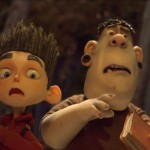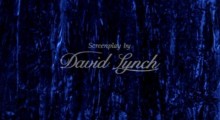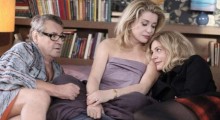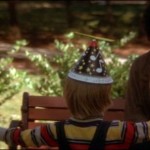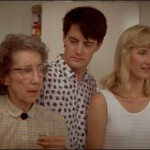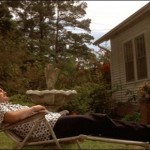Columns
-
Shooting With John: A Performance Behind The Lens
It was a hazy Saturday afternoon in Berne, New York, and a motley crew of filmmakers holding shotguns, aimed at the sky, surrounded me. My mouth was dry and I felt the mind’s eye going black while gripping my barrel. “What the hell am I doing here and who are these strangers?” Well, I was asked to join a small group of filmmakers to shoot skeet and talk shop (and sadly, not form a militia). This past year was a whirlwind tour with my first feature art/documentary, Convento, which premiered at SXSW, played a bunch of fests and was picked up […]
-
The Week in Cameras: Sony NEX-EA50 and Zacuto Shootout
New Large-Sensor Camera From Sony Sony has announced another new camera, the Sony NEX-EA50, which fits somewhere between the very consumer-ish NEX-VG20 and the semi-professional NEX-FS100. The common design element of NEX cameras is the use of Sony’s E-mount, which has a very shallow flange depth – the distance from the mount to the sensor – making it possible to use a variety of lens mounts with an appropriate adapter. The NEX-EA50 is clearly aimed at the event and documentary shooter. It has a new body shape with an integrated shoulder pad (which can be adjusted), XLR audio inputs, and comes […]
-
Lady Vengeance: Trailer Happy, Scaring the Children Edition

Trailers have the ability to psyche us up, freak us out, turn us off, and lead us very, very astray, but the heightened anticipation is part of the fun, regardless of how accurate a representation of the film that cleverly constructed little bugger ends up being in the end. Recently there’s been a spate of trailers for horror-themed animated children’s films, starting with ParaNorman (pictured above), which opened today. So which of these flicks is most likely to either give your kids nightmares, or send them down a lifelong path of genre appreciation? Let’s judge a book by its cover […]
-
The Blue Velvet Project, #152

Second #7144, 119:04 [Final post. Thank you to Scott Macaulay for taking a chance with this.] The blue curtain, creating the conditions for its own strange, vertical, blue-noise static. Remainders: 45,000 = total words in project 2 = frames that feature Dorothy, Jeffrey, and Sandy together 3 = frames including Aunt Barbara 17 = frames in which no human being appears 20 = frames featuring Jeffrey and Dorothy 23 = frames featuring Jeffrey and Sandy Robin Wood, from his classic 1979 essay “An Introduction to the American Horror Film”: Some version of the Other [include, simply] other people. It is […]
-
“Blue Velvet Project” Creator Nicholas Rombes

One year ago, Nicholas Rombes proposed “The Blue Velvet Project” to me at Filmmaker. For 12 months, three times a week, he would scrutinize a single frame from David Lynch’s modern classic, looking both inside and outside of its aspect ratio for correspondences, allusions and meanings. For Rombes, it would be another in his “time-based” critical film essays — appropriately so, for it was because of another of these columns, 10/40/70 at The Rumpus, that I discovered his writing in the first place. (In fact, I interviewed him previously about this other fascinating project.) Nick had contributed to Filmmaker before […]
-
Beloved — A Hammer to Nail Review

(Beloved world premiered at the 2011 Cannes Film Festival and was picked up for distribution by IFC Films. It opens theatrically on August 17, 2012. Visit the film’s website to learn more.) Beloved, the latest film from French writer/director Christophe Honoré, uses the history of the late 20th century as a framework for exploring the difficult love affairs of a mother, Madeleine (played as a young woman by Ludivine Sagnier and as an older woman by Catherine Deneuve) and her daughter, Vera (Chiarra Mastroianni). Like much of Honoré’s work, the movie is rich with allusions not only to literary and theatrical forms, but […]
-
The Blue Velvet Project, #151

Second #7097, 118:17 (Note: the final post in the project goes up Friday.) A confession, of a different sort, about how a movie saved a young man. Can a scene from a movie detour your life, turn you in a new direction? I think it can, in the same way that a book read and just the right age can, or a band can by the sheer force of its ideas turned sonic. (One of the self-imposed rules for this project was to avoid the personal, the anecdotal, but figuring this is the second-to-last post . . .) Blue Velvet […]
-
Shooting With John: Lest We Forget
Perhaps it was no coincidence, then, that on the morning of my return flight from LGA, my stomach peppered on too little bagel and too much coffee, I came across the tidbit of news that traffic would be jammed due to an animal convoy truck that had crashed wide open, spilling several cows to run rampant across Dallas-Fort Worth. Several had been killed in the wreckage, a few had laid down to rest, and yet an even bigger number had mustered their courage to brave the zig-zagging pattern of screeching 18-wheelers and high tail it to the fields that must […]
-
The Blue Velvet Project, #150

Second #7050, #117:30 It’s as if the movie has gone back in time; Jeffrey and Sandy look so young. “I don’t see how they could do that,” Aunt Barbara (Frances Bay) says, looking at the robin on the windowsill with the live bug (perhaps one of the black beetles from the beginning of the film) in its beak, “I could never eat a bug.” She speaks these words just before inserting something black into her mouth. In The Plague of Fantasies, Slavoj Žižek suggests that fantasy does not simply realize a desire in a hallucinatory way: rather, its function is […]
-
The Blue Velvet Project, #149

Second #7003, 116:43 The camera pulls back, low like in the beginning when it entered the lawn grass, to reveal Jeffrey, lounging, Sandy just having told him that “lunch is ready.” A concrete angel looks over him as he suns himself in his black pants and heavy black shoes. Order has been restored, but something has changed, something is different. You can feel it in the framing of the shot, in the oddly canted way that Sandy and the house bend inward, towards the center. In his recent book In the Dust of This Planet, Eugene Thacker questions the assumption […]
